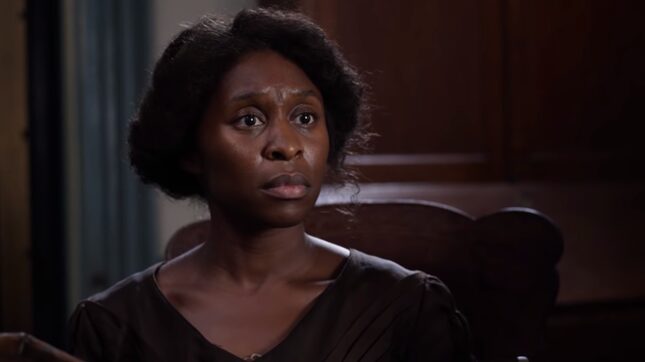
Screenshot: Focus Features
This post contains minor plot spoilers and is based on a screening of Harriet at the 2019 Toronto International Film Festival. The movie hits theaters November 1.
Harriet Tubman’s story is familiar. One of the most famous American activists, she freed over 70 slaves, was the first woman in America to lead an armed expedition, and fought for women’s suffrage before she died at 91 years old. Given the sheer amount of comic book adaptations we must endure every year, there logically should have been at least three Harriet Tubman biopics by now. Instead, over 100 years after her death, Kasi Lemmons has finally brought Tubman’s story to the big screen for the first time in Harriet.
History tells us that over the course of her work with the Underground Railroad, Tubman made over a dozen rescue missions. It is also well known that as a child, Tubman suffered a major brain injury at the hands of the man who enslaved her, which later sparked visions and messages from God. Rather than showing us how Tubman survived her first escape on her own from Maryland to Pennsylvania—where she would likely have to fend off animals, find shelter, and food—Lemmons instead relies heavily on the supernatural aspects of Tubman’s survival, the visions and messages from God which guided her and other slaves to safety. While her visions were well-documented as aiding her voyages, solely relying on her otherworldly instincts feels far less potent than if we were to see the true realities of her journey.
The film opens with Cynthia Erivo as Tubman (when she was known as Araminta Ross) resting in a field before her husband John Tubman (Zachary Momoh) comes to embrace her. It’s a sweet moment, rare for a movie about slavery. It feels almost revolutionary that our first image of a fictionalized Tubman is that of a real, vulnerable person with love in her life—she’s not just a hero. Their moments of tenderness are fleeting, though. When Tubman’s husband, a free man, tells her enslaver that he has found a way for his wife to also be free, trouble begins. Given no choice but to escape to Pennsylvania after her master’s death, Tubman tells her master’s son Gideon (played by Joe Alwyn, who says “nigger” a whole lot and is perversely in love with Tubman), as he nearly catches her that she’d rather die than be enslaved. She is determined to be free.In an attempt to pack in as much of Tubman’s heroism as possible, the film relies heavily on montages and music to set the mood.
Throughout the film, Erivo’s Tubman endures tearful reunions with family members and risks her life to complete numerous journeys to free slaves, but it all somehow feels flat and disconnected. Erivo is mesmerizing as Tubman; she performs with a sharpness and warmth that brings Tubman to life. Only, there’s so much Erivo can do as the film shifts away from Tubman as a person to Tubman as a superhero. There’s an emphasis on how selfless she was and her dedication to freedom for all, but every time the curtain is pulled back to offer more vulnerability, it’s never enough. In an attempt to pack in as much of Tubman’s heroism as possible, the film relies heavily on montages and music to set the mood. Of course, very little “good” happens in a movie about slavery, but it once again takes away from what we want to see more of—Harriet Tubman.
As with most film adaptations of real slavery-era stories, it’s easy to veer towards the fetishistic when documenting a violent period in time. The most gruesome horrors of slavery have been well represented on screen. Harriet is not one of those movies. It doesn’t shy away from the very real violence endured by enslaved people, but the audience isn’t forced to understand the horrors of slavery purely through physical suffering. By default, Harriet is only our first real cinematic introduction to Harriet Tubman beyond her heroism. And while it doesn’t adequately display the talents of the criminally underrated Kasi Lemmons or Cynthia Erivo, people are finally getting to see Tubman in a real way.
Sarah Hagi is a writer living in Toronto.